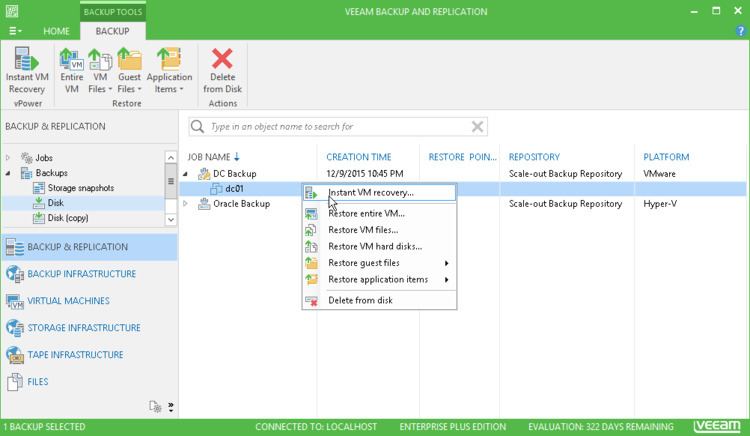Developer(s) Veeam Software Development status Active | Initial release February 26, 2008 Written in C# | |
 | ||
Stable release v9.5 / November 16, 2016 Operating system | ||
Veeam Backup & Replication is a proprietary backup and disaster recovery software developed by Veeam for virtual environments built on VMware vSphere and Microsoft Hyper-V hypervisors. The software provides backup, restore and replication functionality for virtual machines.
Contents
Operation
Veeam Backup & Replication operates at the virtualization layer. It backs up VMs at the image-level using a hypervisor’s snapshots to retrieve VM data. Backups can be full (a full copy of VM image) or incremental (saving only the changed blocks of data since the last backup job run). Backup increments are created using the built-in changed block tracking (CBT) mechanism. The available backup methods include forward incremental-forever backup, forward incremental backup, and reverse incremental backup. Additionally, there’s an option to perform active full and synthetic full backups.
Veeam Backup & Replication provides automated recovery verification for both backups and replicas. The program starts a VM directly from a backup or replica in the isolated test environment and runs tests against it. During the verification, the VM image remains in a read-only state. This mechanism can also be used for troubleshooting or testing patches and upgrades.
Backup storage
Veeam Backup & Replication supports software-defined storage technology. It allows organizing a scalable backup repository from a collection of heterogeneous storage devices. Backups can be stored on-premises, transferred to off-site repositories via the WAN, saved to tape media for long-term retention, or sent to cloud storage. Cloud storage support is available on an Infrastructure-as-a-Service (IaaS) model. Veeam's technology, Cloud Connect, provides integrated and secured backup to the cloud through Veeam-powered service providers.
Veeam Backup & Replication is storage-agnostic, yet has specialized storage integrations with some storage systems such as EMC VNX, EMC VNXe, HP 3PAR, HP StoreVirtual, NetApp and Nimble. It uses storage system snapshots as a source for backups and recovery of VMware VMs with disks residing on storage volumes.
Replication
Along with backup, Veeam Backup & Replication can perform image-based VM replication. It creates a “clone” of a production VM onsite or offsite and keeps it in a ready-to-use state. Each VM replica has a configurable number of failover points. Image-based VM replication is also available via Veeam Cloud Connect for Disaster Recovery as a Service (DRaaS).
Recovery
The software provides a number of data recovery options, including:
Entire VM recovery:
File-level recovery:
Virtual drive restore:
Application-item recovery:
Optimization
Veeam Backup & Replication decreases backup files size and data traffic with built-in data deduplication and compression. There is support for deduplicating storage systems such as EMC Data Domain, ExaGrid and HP StoreOnce Catalyst. Using deduplicating storage appliances as backup repositories allows achieving greater levels of deduplication ratios. Veeam Backup & Replication also provides built-in WAN acceleration to reduce the bandwidth required for transferring backups and replicas over the WAN.
Architecture
Built on a modular scheme, Veeam Backup & Replication allows for setting scalable backup infrastructures. The software architecture supports onsite and offsite data protection, operations across remote sites and geographically dispersed locations. The installation package of Veeam Backup & Replication includes a set of mandatory and optional components that can be installed on physical or virtual machines.
Mandatory components
Optional components
Editions
Veeam Backup & Replication is positioned as a part of the Veeam Availability Suite bundle (which includes Veeam ONE for monitoring, reporting, and capacity planning), but can also be installed as a standalone product. It is available in three editions based on the level of provided functionality. The product is licensed by the number of CPU sockets purchased.
